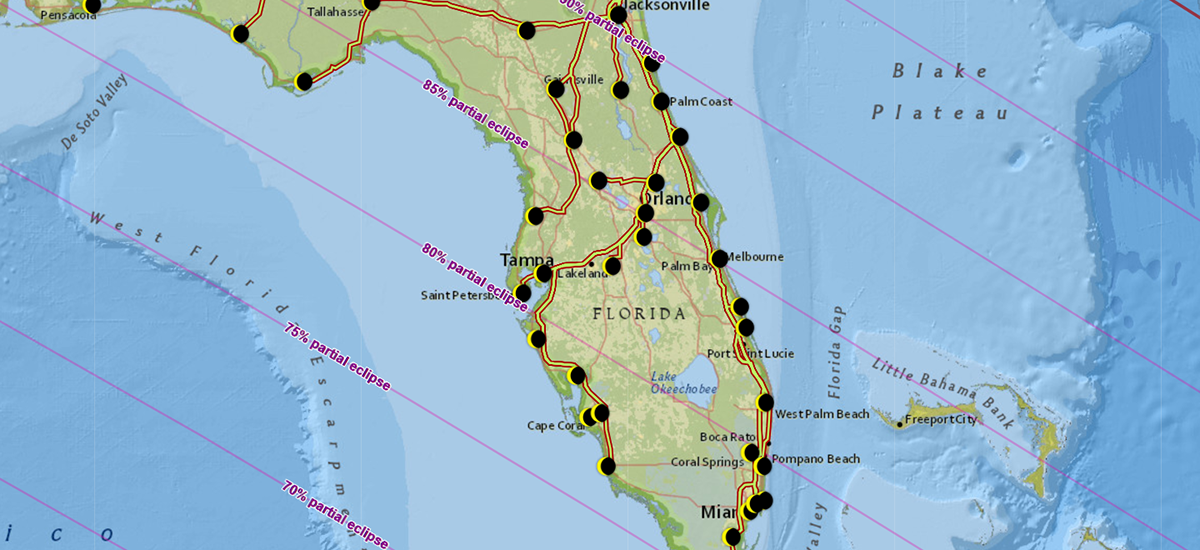
 Your Credit Estimate
Your Credit Estimate
 Your Credit
Your Credit
Your zip code helps us provide you with the most accurate vehicle pricing and vehicle availability.
We estimate your credit score to give you an idea of your monthly payments. To get an accurate payment amount, complete our credit application by clicking the Start Credit Application button below.
start credit application
On August 21, the Great American Eclipse will take place and it will be viewable in numerous states across the U.S. Anyone who’s a lover of astronomy has been screaming on the inside since they heard about it. For those that have done the research, the coast-to-coast solar eclipse is a ONCE IN A LIFETIME experience. But, can you see it if you reside in Florida?
What’s a Solar Eclipse?
The Great American Eclipse is the name given to this year’s solar eclipse, and unlike a lunar eclipse where the Moon is overshadowed by the shadow of Earth, and seemingly becomes invisible (or a Blood Moon), a solar eclipse is a lot more interesting. A solar eclipse is the result of the Moon’s orbit crossing paths between the Sun and the Earth, casting a shadow on the Earth itself.
Yes, whomever is witnessing the totality of the solar eclipse will literally be standing in the shadow of the Moon. Chills, right? Here’s the catch, you have to be in the area of totality to witness a 100% solar eclipse. Meaning, unless you reside in or travel to one of the states that is lucky enough to be in the path of the Moon’s shadow (did someone say road trip?), you’ll only see a partial solar eclipse. Still cool, but why miss out?
After all, the U.S. hasn’t seen a partial solar eclipse since the 1930s, and it hasn’t had a total solar eclipse since 1918. We’re not bluffing when we say it’s a once in a lifetime experience. Of course, astronomers may predict the next solar eclipse, but there’s too many variables in space to really know what will happen 10 or even 30 years from now.
What About Those of Us in Florida?
If not able to travel, and if you haven’t made plans by now, we wish you luck, because all the hotels are pretty much booked and a total solar eclipse may just not be in the cards. Florida is just a tiny bit too south of the eclipse line to see a total eclipse. From Key West to Jacksonville, the most one will witness is a 90% partial solar eclipse, and that’s if they travel all the way to Jacksonville. The further north, the more totality possible.
Here’s a rundown though of the major cities in Florida and how much of the totality will be seen, from south to north:
Key West - 70 - 72%
Miami - 78%
Naples and Fort Lauderdale - 78 - 80%
West Palm Beach and Tampa - 81 - 82%
Orlando - 85%
Daytona - 88%
Tallahassee - 86 - 87%
Jacksonville - 90 - 91%
The southernmost point of solar eclipse totality is in Folly Beach, South Carolina, and it only lasts for nine seconds. So if travelling that far, we suggest driving a little further along the coast. Take a look at the map above for a good idea of where to go in Florida for how much of the eclipse to witness, courtesy of thegreatamericaneclipse.com. Keep in mind, the only way to watch the eclipse safely is with special, certified eclipse glasses. Just because the moon is partially in the way, doesn’t mean the sun’s harmful rays “vanish.” The only time one can look directly at the eclipse without glasses is the point of totality, something Florida won’t get to see - we know, a bit of a bummer, maybe next life?
Don’t forget, the 2018 Mitsubishi Eclipse Cross will also be released later this year. With all of the cool technology in the Mitsubishi Eclipse Cross though, it may be around for a lot longer than a single lifetime.